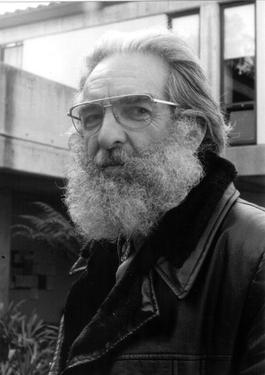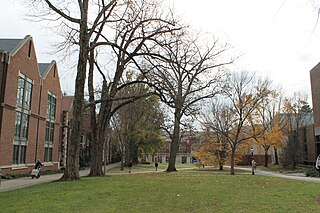Related Research Articles

Manuel DeLanda is a Mexican-American writer, artist and philosopher who has lived in New York since 1975. He is a lecturer in architecture at the Princeton University School of Architecture and the University of Pennsylvania School of Design, where he teaches courses on the philosophy of urban history and the dynamics of cities as historical actors with an emphasis on the importance of self-organization and material culture in the understanding of a city. DeLanda also teaches architectural theory as an adjunct professor of architecture and urban design at the Pratt Institute and serves as the Gilles Deleuze Chair and Professor of Philosophy at the European Graduate School. He holds a BFA from the School of Visual Arts (1979) and a PhD in media and communication from the European Graduate School (2010).

Maurice Stevenson Bartlett FRS was an English statistician who made particular contributions to the analysis of data with spatial and temporal patterns. He is also known for his work in the theory of statistical inference and in multivariate analysis.
Aces II is an ab initio computational chemistry package for performing high-level quantum chemical ab initio calculations. Its major strength is the accurate calculation of atomic and molecular energies as well as properties using many-body techniques such as many-body perturbation theory (MBPT) and, in particular coupled cluster techniques to treat electron correlation. The development of ACES II began in early 1990 in the group of Professor Rodney J. Bartlett at the Quantum Theory Project (QTP) of the University of Florida in Gainesville. There, the need for more efficient codes had been realized and the idea of writing an entirely new program package emerged. During 1990 and 1991 John F. Stanton, Jürgen Gauß, and John D. Watts, all of them at that time postdoctoral researchers in the Bartlett group, supported by a few students, wrote the backbone of what is now known as the ACES II program package. The only parts which were not new coding efforts were the integral packages. The latter was modified extensively for adaptation with Aces II, while the others remained very much in their original forms.
Mario Davidovsky was an Argentine-American composer. Born in Argentina, he emigrated in 1960 to the United States, where he lived for the remainder of his life. He is best known for his series of compositions called Synchronisms, which in live performance incorporate both acoustic instruments and electroacoustic sounds played from a tape.

The Bartlett Faculty of the Built Environment is the academic centre for the study of the built environment at University College London (UCL), part of the University of London in London, United Kingdom. It is home to thirteen departments that have expertise in individual fields of the built environment, including the Bartlett School of Architecture, Bartlett School of Planning, Bartlett Development Planning Unit, and Centre for Advanced Spatial Analysis. The Bartlett is consistently ranked the highest in Europe and the UK and among the highest in the world for the "Architecture and the Built Environment" category in major rankings. In the 2021 QS World University Rankings, it was ranked second in the world, and was ranked third in the 2022 Rankings.

Sir Peter Cook is an English architect, lecturer and writer on architectural subjects. He was a founder of Archigram, and was knighted in 2007 by the Queen for his services to architecture and teaching. He is also a Royal Academician and a Commandeur de l'Ordre des Arts et des Lettres of the French Republic. His achievements with Archigram were recognised by the Royal Institute of British Architects in 2004, when the group was awarded the Royal Gold Medal.

Peter Reyner Banham Hon. FRIBA was an English architectural critic and writer best known for his theoretical treatise Theory and Design in the First Machine Age (1960) and for his 1971 book Los Angeles: The Architecture of Four Ecologies. In the latter he categorized the Los Angeles experience into four ecological models and explored the distinct architectural cultures of each. A frequent visitor to the United States from the early 1960s, he relocated there in 1976.
Iain Borden is an English architectural historian and urban commentator.

Joseph Rykwert CBE is Paul Philippe Cret Professor Emeritus of Architecture at the University of Pennsylvania, and one of the foremost architectural historians and critics of his generation. He has spent most of his working life in the United Kingdom and America. He has taught the history and theory of architecture at several institutions in Europe and North America. Rykwert is the author of many influential works on architecture, including The Idea of a Town (1963), On Adam's House in Paradise (1972), The Dancing Column (1996) and The Seduction of Place (2000). All his books have been translated into several languages.
Log is an independent magazine on architecture and the contemporary city that has been published by the Anyone Corporation since 2003 and is edited by Cynthia Davidson. The tagline for the magazine is "Observations on Architecture and the Contemporary City." The magazine is published three times a year, with general "open" issues punctuated by occasional thematic issues. It contains essays and articles by architectural and urban theorists and historians, curators, architects, and artists, including Pier Vittorio Aureli, Mario Carpo, Patrik Schumacher, Preston Scott Cohen, K. Michael Hays, Sylvia Lavin, Paola Antonelli, Greg Lynn, Antoine Picon, François Roche, Anthony Vidler, Paul B. Preciado, Paul Virilio, Peter Eisenman, Reinhold Martin, Phyllis Lambert, Jeff Kipnis, Alejandro Zaera-Polo, Robert Somol, Daniel Sherer, and Hubert Damisch.
Philip J. Goad is an Australian academic, currently serving as Professor of Architecture in the Faculty of Architecture, Building and Planning at the University of Melbourne. He is also a former President of the Victorian Chapter of the Royal Australian Institute of Architects. Phillip became Chair of the Heritage Council of Victoria in July 2021.

The School of Architecture at UNAM is one of the leading schools of architecture and design in Mexico. It offers undergraduate and postgraduate studies in architecture, landscape architecture, urbanism and industrial design.

Benjamin H. Bratton is an American Philosopher of Technology known for his work spanning social theory, computer science, design, artificial intelligence, and for his writing on the geopolitical implications of what he terms "planetary scale computation".
Jonathan Hill is an English architect, architectural historian, and book author/editor.
Algorithms-Aided Design (AAD) is the use of specific algorithms-editors to assist in the creation, modification, analysis, or optimization of a design. The algorithms-editors are usually integrated with 3D modeling packages and read several programming languages, both scripted or visual. The Algorithms-Aided Design allows designers to overcome the limitations of traditional CAD software and 3D computer graphics software, reaching a level of complexity which is beyond the human possibility to interact with digital objects. The acronym appears for the first time in the book AAD Algorithms-Aided Design, Parametric Strategies using Grasshopper, published by Arturo Tedeschi in 2014.
Jeanne Peiffer is a Luxembourg historian of mathematics.
Jane Rendell is an architectural historian, cultural critic and art writer. She has taught at Chelsea College of Art and Design, Winchester School of Art, and the University of Nottingham. She has been based at the Bartlett School of Architecture at UCL since 2000, where she has been Professor of Architecture and Art since 2008, teaching primarily across the Situated Practice, Architectural History and PhD programmes. She was Director of Architectural Research (2004–10) and Vice Dean Research (2010-3). She is currently Director of Architectural History and Theory and leads the Bartlett’s Ethics Commission.

Princeton University School of Architecture is the name of the school of architecture at Princeton University. Founded in 1919, the School is a center for teaching and research in architectural design, history, and theory. The School offers an undergraduate concentration and advanced degrees at the master's and doctoral levels.
Peter John Bartlett was a New Zealand architect and professor of architectural design.
Murray Fraser is Professor of Architecture and Global Culture at the Bartlett School of Architecture, University College London (UCL).
References
- ↑ "Mario Carpo". Personal website. March 1, 2023.
- ↑ "Prof Mario Carpo". The Bartlett School of Architecture. December 21, 2016.
- ↑ "Mario Carpo". i-o-a.at. Archived from the original on 2021-10-05.